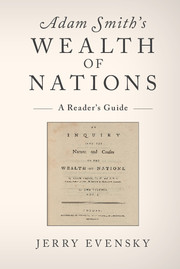Book contents
- Frontmatter
- Contents
- Acknowledgments
- Prologue: The Purpose of This Work
- 1 Adam Smith's Moral Philosophical Vision: The Context of His Economic Analysis
- 2 The Wealth of Nations: Book I
- 3 The Wealth of Nations: Books II and III
- 4 The Wealth of Nations: Book IV
- 5 The Wealth of Nations: Book V
- Epilogue: Adam Smith and Laissez-Faire
- References
- Index
3 - The Wealth of Nations: Books II and III
Published online by Cambridge University Press: 05 September 2015
- Frontmatter
- Contents
- Acknowledgments
- Prologue: The Purpose of This Work
- 1 Adam Smith's Moral Philosophical Vision: The Context of His Economic Analysis
- 2 The Wealth of Nations: Book I
- 3 The Wealth of Nations: Books II and III
- 4 The Wealth of Nations: Book IV
- 5 The Wealth of Nations: Book V
- Epilogue: Adam Smith and Laissez-Faire
- References
- Index
Summary
Having, in Book I, set the stage for his analysis of the dynamic that drives the engine of material progress in commercial society, in Book II Smith turns to that dynamic.
Progress is driven by the continuous reinvestment of stock into circuits of production that put productive labor to work. Capital is that portion of accumulated stock that is allocated to these circuits. To the degree that parsimony grows this capital stock with each circuit, the division of labor is refined, productivity is enhanced, and there is growth in the wealth of the nation.
Money plays a crucial role in this dynamic. Smith examines the forms and functions of money, discusses the role and challenges of the banking system in a commercial system, and explains how a well-regulated paper currency can facilitate the expansion of trade.
The division of labor is limited by the extent of the market, so to justify capital deepening that leads to an ever finer division of labor and increasing productivity, the market must be expanding. In Smith's analysis the market grows through a process of the sequential widening of the circuits of trade. It is this dynamic of capital flowing into ever expanding circuits that drives the engine of material progress in commercial society.
“INTRODUCTION”
In the first, rude state, of humankind's evolution human beings live hand to mouth. There is no division of labor, no surplus, no accumulation. The progress of opulence, humankind's material progress, begins with the emergence of private surpluses that allow personal accumulation. This accumulation is necessary for the division of labor because the division of labor is predicated on exchange – and one must have a “stock sufficient to maintain him … till he has not only completed, but sold” his product (WN, 277).
As the accumulation of stock must, in the nature of things, be previous to the division of labour, so labour can be more and more subdivided in proportion only as stock is previously more and more accumulated.
- Type
- Chapter
- Information
- Adam Smith's Wealth of NationsA Reader's Guide, pp. 64 - 105Publisher: Cambridge University PressPrint publication year: 2015
- 1
- Cited by



